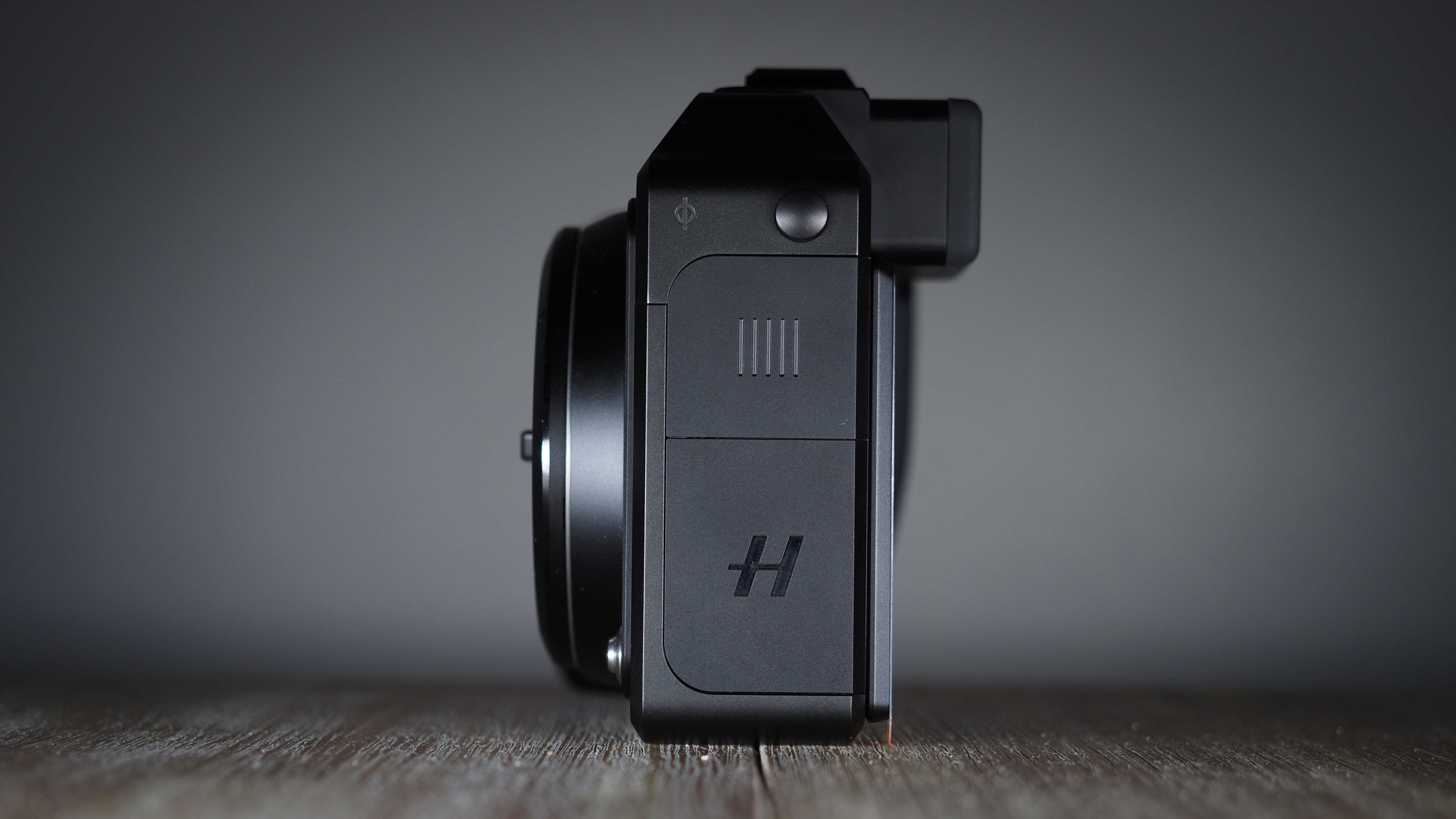Digital Camera World Verdict
The Hasselblad X2D is a camera that pulls no punches. With a 100MP sensor, native 16-bit color, 15 stops of dynamic range, 7 stops of in-body image stabilization and 1TB of internal storage, it's holding absolutely nothing back and goes toe to toe with Fujifilm's GFX100 series. While it lacks any video capability whatsoever, as a pure imaging machine it's practically untouchable. The yardstick around here may just have changed!
Pros
- +
Stunning 100MP imaging
- +
7 stops of stabilization
- +
1TB internal storage
Cons
- -
No video
- -
No joystick
- -
Touchscreen tilt only
Why you can trust Digital Camera World
The Hasselblad X2D 100C feels like a camera that's long overdue, but nonetheless a camera that has been well worth the wait. It stands as by far the manufacturer's most capable camera ever, and sets new standards in a couple of areas for medium format photography.
A 100MP monster, the Hasselblad X2D not only doubles the resolution of the existing So the Hasselblad X2D already has what it needs to take its place the best Hasselblad camera. Is it also the best medium format camera, period? Let's take a closer look. (which remains on sale for those who require lower resolution) but improves upon its predecessor in every single respect… well, bar one, which we'll get to shortly.
It features the introduction of in-body image stabilization, offering superior compensation to its 100MP rivals from Fujifilm. It boasts an extra stop of dynamic range, lower base ISO, a far higher resolution viewfinder, a tilting touchscreen, CFexpress card support and even an internal SSD for storage.
So the Hasselblad X2D already has what it needs to take its place the best Hasselblad camera. Is it also the best medium format camera, period? Let's take a closer look.
Hasselblad X2D 100C: Specifications
Sensor: 100MP back-side illuminated CMOS medium format
Lens mount: Hasselblad X System
Autofocus: Hybrid phase detect with 294 PDAF zones
Image stabilization: 5-axis, 7 stops
ISO range: 64 to 25,600
Video: None
Viewfinder: 0.5-inch 5.76 million dot OLED EVF, 100% coverage, 1.0x magnification
LCD: 3.6-inch, 2.36 million-dot tilting touchscreen
Memory: Internal 1TB SSD, 1x CFexpress Type B (up to 512GB)
Max burst: 3.3fps (14-bit color)
Connectivity: Wi-Fi 6, Bluetooth, USB-C 3.1 Gen2
Size: 148.5 x 106 x 74.5mm
Weight: 790g body only (895 with battery)








Hasselblad X2D 100C: Key features
Packing a 100MP medium format back-side illuminated image sensor (yes, the same one that's in the Fujifilm GFX100 and Fujifilm GFX100S), the Hasselblad X2D delivers 15 stops of dynamic range and native 16-bit color depth (a step up from the X1D II, which was 14-bit remapped to 16-bit).
Hasselblad has also engineered its own in-body image stabilization (IBIS) system that offers 5-axis correction and a remarkable 7 stops of compensation – a full stop more than the GFX 100S.
The best camera deals, reviews, product advice, and unmissable photography news, direct to your inbox!
The X2D also comes with 1TB of internal storage, capable of holding around 4,700 RAW files. This acts as a "second memory card" to complement the new CFexpress Type B slot, which currently supports cards up to 512GB.
One of the most significant features for the Hasselblad X2D is the implementation of hybrid phase detect autofocus, which features 294 zones and around 89% coverage. The three newly launched X System lenses – the Hasselblad XCD 2,5/38V, Hasselblad XCD 2,5/55V and Hasselblad XCD 2,5/90V – all feature a new autofocus module that works in tandem with the new AF system to deliver faster focusing speeds.
Remember the "bar one" thing we mentioned at the top of this review? Well, the Hasselblad X2D fails to outdo its predecessor (or its rivals) in one department: it has no video capability whatsoever. And, unlike the choppily patched X1D II, that functionality won't be introduced by firmware at a later date.
Hasselblad X2D 100C: Performance
As somebody who loved the X1D II, but simply couldn't fall in love with it due to its various shortcomings and sluggishness, I am supremely happy to say that the Hasselblad X2D is the love letter from Sweden I've been waiting for.
The single biggest issue with the X1D series was its molasses-slow contrast detect AF. And bearing in mind that the original GFX100, with a phase detect AF system, was released the same year as the X1D II, it was a big ask to accept a camera system that in many cases was unusable unless you opted for manual focus.
Well, no more. The X2D features phase detect and, while you shouldn't expect the lightning-fast focus times of cameras with smaller sensors, this is a night and day difference in performance.
It turns Hasselblad's mirrorless system from something that begged to be used on sticks, in a studio, into something so responsive that it can now even be considered a capable street photography camera.
Which isn't to say that the focus is magically infallible now – it isn't. Hasselblad doesn't yet have the sophisticated face and eye tracking tools of other companies, and we've found that the AF does occasionally misread a scene with fine detail or busy backgrounds. However, it hits the spot 90% of the time and you can kiss goodbye to the incessant hunting of old.
Speaking of street photography, we weren't kidding. Thanks to the stunning stabilization and the near-perfect ergonomics, we shot handheld run-and-gun street photography all day – at an ultra-low ISO64, and even using "slow" f/2.5 lenses.
And, thanks to the 100MP uber-resolution, it doesn't even matter if you don't have the right lens on you. Check out the image below – we knew that we wanted this shot of the chap smoking a cigarette, but our 45mm lens was too short. No problem! Just do what medium format was always intended to: capture a high resolution scene and crop it down later.
The resulting files are nothing short of jaw-dropping. It goes without saying that they're rich in resolution and dripping with detail, but it's more than that. Listen to Leica owners and they will, sooner or later, mention the "Leica magic". Well, it's time we introduce the term "Hasselblad magic".
Canon is widely regarded to have the finest color science, but to our mind nothing touches the sublime tones captured by the Hasselblad Natural Colour Solution – especially in the native 16-bit format captured by the X2D. It's like having a most gorgeous, filmic LUTs or presets applied to your images straight out of camera. Don't kid yourself about what Leicas or any other cameras promise – if you want a "look", this is it.
As noted, while this obviously isn't going to be as responsive as a Canon EOS R5 or as machine gun-fast as a Nikon Z9, for a medium format camera this is a remarkably nimble performer, giving you the ability not just to sit and work at a meditative pace like the X1Ds did, but freeing you to actually get creative, start freestyling, and throwing the camera around while flicking the dials like a madman.
Does the camera hurt for lack of video? Yes and no. It can't be denied that the GFX100 offers surprisingly capable video. Would it be anyone's first choice to film anything? Of course not. That said, if it's the only camera you happen to have one you, the difference between "not the first choice" and "having no choice" becomes a bit starker.
That said, you don't buy a cinema camera and then complain that it can't shoot stills – so why should you complain that what might be the ultimate photographic machine can't shoot video?
Hasselblad X2D 100C: Lab results
For our lab data comparison, we compared the X2D 100C to its main 100MP medium format rival, the Fujifilm GFX 100S. Pentax's most 'recent' medium format camera, the Pentax 645Z, is also included for reference. And because you no longer have to go medium format to get high resolution, we see how the medium format cameras stack up against the 61MP full-frame Sony A7R IV.
We test resolution using Imatest charts and software, and dynamic range and signal-to-noise ratio with DxO Analyzer.
Resolution (line widths/picture height):
No surprises here – all four cameras perform exactly how we'd expect in terms of detail capture, ranking almost exactly in line with their sensor megapixel counts. The only point of note is how the GFX 100S is able to resolve slightly more detail than the X2D 100C, despite the two cameras having almost the same megapixel count. At low sensitivities the difference isn't really significant, but at ISO 3200 and above the Fujifilm's images are marginally less noisy, meaning fine detail is better retained.
Dynamic range (EV):
All three medium format cameras are closely matched when it comes to capturing dynamic range, though the GFX 100S sustains its peak performance until ISO 1600, whereas the Hasselblad's dynamic range starts to drop after ISO 400. We find that Sony cameras rely quite heavily on Sony's DRO (D-range optimizer) feature when capturing dynamic range, but we have to disable this to ensure a level playing field – hence, the A7R IV doesn't perform particularly well in this test.
Signal to noise ratio (decibels):
This test compares the amount of random noise generated by the camera at different ISO settings as a proportion of the actual image information (the 'signal'). Higher values are better and we expect to see the signal to ratio fall as the ISO is increased.
Here the two 100MP cameras a very closely matched, though the GFX produces very slightly cleaner images than the X2D 100C. Somewhat surprisingly, it's the old Pentax 645Z that leads the pack in this test, proving that despite its age, there's still no substitute for having a large sensor size with a 'lower' megapixel count if you want to minimize image noise.
Hasselblad X2D 100C: Verdict
The Hasselblad X2D is a camera that pulls no punches. With a 100MP sensor, native 16-bit color, 15 stops of dynamic range, 7 stops of in-body image stabilization and 1TB of internal storage, it's holding absolutely nothing back and goes toe to toe with Fujifilm's GFX100 series – and, for our money, it delivers the more pleasing results.
While it lacks any video capability whatsoever, as a pure imaging machine it's practically untouchable. There is just something about Hasselblad's Natural Colour Solution tech that nothing – not even Fujifilm's fantastic color science – can come close to. The X2D quite simply delivers the finest colors we've ever seen straight out of camera, and the files themselves are the richest we've ever played with.
Certainly, if you want a hybrid camera that shoots video, this isn't the body for you. However, if we're honest, videographers don't need medium format and medium format doesn't need videography – the Hasselblad X2D is a phenomenal photographic powerhouse. When only the best will do, look no further.
Read more:
Best medium format cameras
Best Hasselblad lenses
Hasselblad X1D 50C review
Hasselblad X1D II 50C review

James has 25 years experience as a journalist, serving as the head of Digital Camera World for 7 of them. He started working in the photography industry in 2014, product testing and shooting ad campaigns for Olympus, as well as clients like Aston Martin Racing, Elinchrom and L'Oréal. An Olympus / OM System, Canon and Hasselblad shooter, he has a wealth of knowledge on cameras of all makes – and he loves instant cameras, too.











